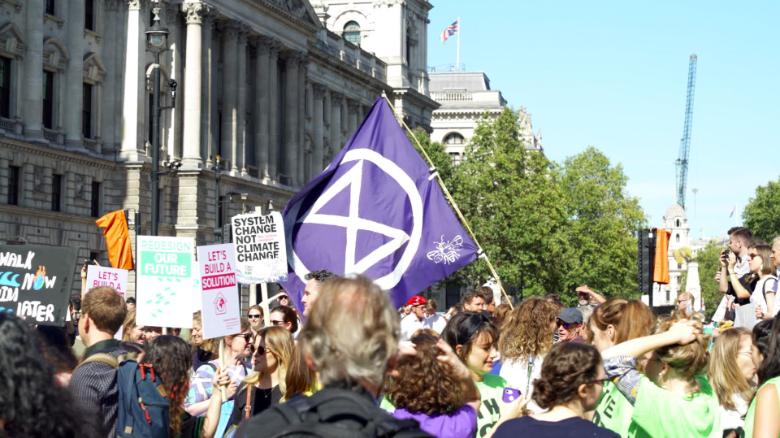A psychedelic journey, a radical strategy and perfect timing: How Extinction Rebellion was made

The lifelong activist had spent decades working on an array of social justice campaigns, but few of them had gained much in the way of lasting traction. In order to bring about real, radical change, Bradbrook felt like something inside her consciousness needed to be unlocked.So the reluctant flier traveled to the jungle-covered mountains of Costa Rica, thousands of miles away from her home in England’s leafy countryside, for a psychedelic retreat.In the space of two weeks, she ingested a flood dose of Iboga, a tree bark used to induce visions; took Kambo, the poisonous secretion of a giant tree frog hailed for its healing powers; and had experiences with ayahuasca, a hallucinogenic brew. All have been used in indigenous cultures for centuries as part of Shamanic spiritual rituals.Bradbrook recalls being terrified but determined to push herself to the limit and divine a greater sense of purpose. During an ayahuasca ceremony one evening, she offered up a prayer calling on the universe to show her the “codes for social change.”Two years later, Extinction Rebellion was born.’This was my prayer being answered’Bradbrook, one of the founders of the world’s most high-profile environmental movements, felt as though the trip had rewired her brain. “It was utterly transformative,” she told CNN in a recent interview at her home in the English town of Stroud. After Bradbrook returned, she ended her marriage and began to work with a group of activists, including Roger Hallam, a Welsh organic farmer pursuing a PhD at King’s College London in radical campaign design. When their first lengthy meeting wrapped, Hallam turned to Bradbrook and said, unprompted, that he had just given her the “codes” she had been searching for. His words sent a chill down her spine. “It’s an Extinction Rebellion mythic story that’s out there, but it’s true,” said Bradbrook, who has a PhD in molecular biophysics herself. “I was very gobsmacked and at the time I remember thinking, ‘goodness me, if he hadn’t used that phrase, I wouldn’t have recognized that this was my prayer being answered.'”Together they helped start the radical campaigning organization Rising Up!, which ultimately spawned Extinction Rebellion in the spring of 2018. It was during a gathering of about 15 activists, crowded into the living room of Bradbrook’s ex-council house, that she said the decision was made to embark on a mission to transform the conversation about the climate emergency. They sketched out a strategy of nonviolent, mass civil disobedience and made it their mission to activate 3.5% of the UK population — roughly 2 million people — in order to force the government to act. The movement’s first demand is perhaps its most salient: that authorities “Tell the truth” about climate change. They started giving talks around the country about the ecological crisis and providing training on nonviolent direct action. Initially, the facilitators outnumbered the participants, but the group’s ranks quickly swelled.From the start, Extinction Rebellion — or XR, as it is known — sought to draw a line in the sand between its movement and past environmental campaigns. In October 2018 the group staged one of its first actions, at the Greenpeace offices in London.Days later, activists rallied in London’s Parliament Square, declaring themselves in open rebellion against the UK government, laying down on the street in front of the Palace of Westminster in an act of defiance. Greta Thunberg, the young Swedish activist who started the Fridays for Future strike movement, joined them.Since then, Extinction Rebellion has spun off nearly 500 affiliates across more than 70 countries and staged protests around the world. Activists of all ages have glued themselves to buildings, jumped on top of trains, and shut down entire parts of cities, leading to thousands of arrests.Extinction Rebellion has distinguished itself from other environmental movements in several ways — not least in their apocalyptic language. By virtue of its very name, the group is emphasizing the existential threat posed to humanity by the climate crisis, and suggesting that major social and system-wide change is the only way to alter the planet’s current trajectory.Convincing protesters to risk arrest en masse — among them grandparents and others who had never before considered breaking the law — is another key part of the group’s approach. The idea is that by overwhelming the state, putting pressure on police forces and the criminal judicial system, the issue of climate change will be forced onto the table.”I think Simon once said, ‘it’s like we need the activists to get on the yoga mats and the yoga mat people to get on the street,'” said Bradbrook, referring to Simon Bramwell, her former partner and another co-founder of Extinction Rebellion. “Some people see protesting as a bit of a dirty thing, and certainly the idea of getting arrested was not on people’s radar.”That tactic has been criticized by British authorities, with a former head of counter-terrorism at Scotland Yard describing XR as “anarchism with a smile.” In October, UK Prime Minister Boris Johnson disregarded the protesters as uncooperative “crusties,” and police in London banned them from the city (a decision that was ultimately ruled unlawful). Two days later, activists halted trains in the UK capital during rush hour, drawing the ire of the public, who accused them of being too white, too middle-class, too out of touch.Despite the criticism, Extinction Rebellion has made significant strides in a short period: Holding meetings with politicians, pushing the UK Parliament to declare a climate emergency — the first legislative body in the world to do so — and shifting public discourse about ecological breakdown. “XR has, to date, been hugely successful in ‘moving the dial’ and politicizing the issues. There is a much greater awareness in policy circles, and in the general public, of the urgency of tackling environmental and climate degradation,” Tim Benton, research director of the energy, environment and resources program at London-based think thank Chatham House, said, adding that the question is whether on-the-streets activism will face diminishing returns in future.The group’s rapid rise has left many people — including some of its founders — wondering how they managed it, and whether the movement can maintain the momentum.’By stepping forward, you become scrutinized’When CNN met Bradbrook at her home in Stroud, she was whirring around her living room, vacuuming mugwort leaves off the floor (she had been making sachets for tea the day before). Save for the pink Extinction Rebellion handbook, “This Is Not A Drill,” tucked away among Nigella Lawson cookbooks on a shelf, along with a sticker bearing XR’s ubiquitous hourglass symbol on a computer in the corner, nothing about the room where it all started screamed rebellion. Bradbrook’s two teenage sons had left for school, and she was getting ready for a jam-packed day of calls, media appearances and organizing. She’s become the closest person to a leader in a movement designed to be a non-hierarchical “holacracy.”The long-time campaigner says she was born to do this work — she joined the Green Party as an activist when she was just 14 and has been involved in social justice movements ever since.The daughter of a coal miner, who grew up in Yorkshire, Bradbrook’s working-class roots belie the accusations of elitism leveled at Extinction Rebellion by its critics (not to mention some of its members). Bradbrook feels like she can’t win either way. “In the past when I was on protests, it was always people shouting out of the cars, ‘get a job, get a bath, get a haircut,'” Bradbrook said. “So, am I a dole-scrounging hippie, or am I middle class and privileged? Just by stepping forward, somehow you become scrutinized, rather than the actual issues that count.”The issues that count are stark and existential, in Bradbrook’s view: Biodiversity loss, water shortages, crop failure, extreme weather and the impending collapse of civilization.Much of her time now is spent criss-crossing the UK to bring that message to the masses. After our interview, she’s off to BBC Radio 2 in Cardiff — apologizing in advance for having to take a car, as the train would take twice as long.Her phone buzzed incessantly with calls about the latest controversy. The day before, her fellow XR co-founder and friend, Roger Hallam, sparked outrage when he referred to the Holocaust as “just another f**kery in human history” during an interview with the German newspaper Die Zeit. His remarks were condemned by the German branch of Extinction Rebellion as anti-Semitic, belittling and relativizing. Hallam later apologized. Bradbrook agreed, saying Hallam’s comments were awful and outrageous: “I often call him our biggest asset and our worst liability, and I say that to his face.”Hallam, who is widely regarded as the architect of Extinction Rebellion’s strategy and has become something of a lightning rod for the group, has recommended that activists adopt the tactics of movements like the Yellow Vests in France. “We need only a few hundred thousand people to actively break the law and/or support such activities to put us in the ballpark of structural change,” he wrote in his book, “Common Sense for the 21st Century.” The group made the decision early on to distance itself from what Bradbrook called “lefty environmental messaging,” in favor of language that conveys the urgency of the climate crisis. Bradbrook said much of that was crafted by Bramwell, who wrote the group’s “declaration of rebellion.” The document paints a harrowing picture of humanity’s dystopian future, describes the social contract as “null and void,” and calls upon peaceful British citizens to join Extinction Rebellion’s uprising against the government.”We refuse to bequeath a dying planet to future generations by failing to act now,” Bramwell wrote.Perfect timingSimon Bramwell is just as impassioned in person as he sounds on paper.A towering figure with a booming voice, he dominated the conversation among a group of XR activists who had gathered in The Beacon, a community hub space in the center of Stroud. Bramwell was eager to dispel the folklore that’s grown up around the group and its founders, saying that Hallam and Bradbrook were by no means the “Alpha and Omega of the movement.” In Bramwell’s view, XR was stitched together by a wide-ranging group of British activists who, over the course of two years, experimented in law-breaking civil disobedience and mass nonviolent direct action on behalf of the environment, much of which was concentrated in the capital.In the early days of XR, a handful of activists worked out of people’s bedrooms and flats, before moving to a cramped one-room office in Euston that stank of rotten hummus, Bramwell said. Now the rebellion is organized out of a buzzy co-working space in London’s hip east end, with hundreds of people cycling in and out for meetings conducted over video chat with chapters around the world. “It’s been an absolutely explosive debut and left a lot of people wondering how that happened,” Bramwell said, adding that much of the group’s meteoric rise has been down to timing. “I think there’s been a lot of serendipity involved.”When Extinction Rebellion officially launched, Thunberg’s Fridays for Future student strikes were gaining traction, a United Nations report warning of unprecedented temperature rise by 2030 had just dropped, and an academic paper discussing the need for “deep adaptation” in the face of ecologically induced social collapse had lit the internet on fire. Simultaneously, something else was consuming much of the oxygen in the UK: Brexit.David Lambert, another Stroud-based activist who works as a spokesperson for the movement, said the political climate in the UK provided fertile ground for XR to blossom. Years of austerity, combined with the seemingly endless crisis over Britain’s withdrawal from the European Union, had steadily torn at the fabric of society, Lambert said, pushing it to the brink.”That’s what you could see in the referendum and the polarization over Brexit. They’re voting because they want a change. So, in a way, it is very time and place specific, Extinction Rebellion,” Lambert said.Lambert was among a group of XR activists who glued and then chained themselves to the fence in front of Jeremy Corbyn’s house in April. The activists felt the opposition Labour Party leader might be the country’s best shot at delivering radical change, more specifically: committing to reduce greenhouse gas emission to net zero by 2025. Corbyn, who ran on a manifesto to deliver a net-zero-carbon energy system within the 2030s, lost the UK general election earlier this month.By contrast, the newly elected Conservative Party has pledged to hit net-zero by 2050 — a time scale that XR has likened to a death sentence for the planet.”The political gains have been pretty thin, frankly, the carbon neutral target from the government is pretty meaningless,” Lambert said of XR’s success thus far.Where does XR go from here?”Where the f**k is the government?””It’s time to tell the truth!””Change now.”They’re among the many messages emblazoned on bold, neon-colored signs plastered around XR’s open-plan warehouse space in east London. On a Monday afternoon in late November, dozens of people filtered in and out, some clustered around conference tables, others on video chats or attached to their phones.One is Bradbrook, there for meetings, as she is most Mondays and Tuesdays. Before getting onto a two-hour call with an international branch of the movement, Bradbrook sat down to chat with other activists about ongoing actions, like the hunger strike, which, at that time, had been staged outside the Conservative Party headquarters for two weeks. Having put the UK on notice in 2019, Bradbrook said the goal now is to keep the momentum going and push the movement further onto the global stage, all while maintaining XR’s principles.Extinction Rebellion has grown so fast and is so decentralized that it’s almost impossible to keep up with the pace, particularly for those inside of it. One of the biggest challenges for its founders is how to help steer that expansion while also allowing for individual experimentation. That has become a constant balancing act, with the risk looming that an action might alienate the public.In the wake of criticisms, especially over a lack of diversity, Extinction Rebellion is focusing its attention on outreach to different demographics and cultivating regenerative culture, to cope with climate anxiety. The existential question is how it can avoid the same fate of disobedience campaigns of the past, which have fizzled out as a result of waning interest and a lack of impact.For all its ambitions, XR’s long-term success is still far from guaranteed, Bradbrook said. After all, she has seen campaigns like it fall apart before.”This movement has opened a conversation, so it’s already achieved something that I feel glad to be part of, and I hope it carries on,” Bradbrook said. “But I also think, if not, something else will emerge.”






